Extensive Organizations that are Run in Miniature
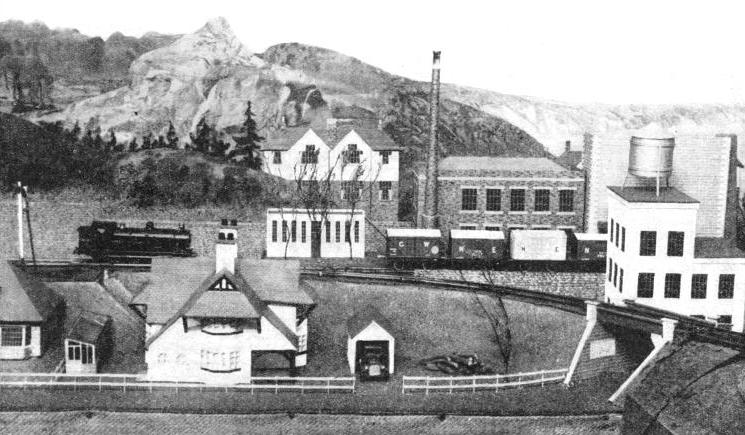
AN ELECTRIC SYSTEM with 500 ft of main line owned by the Rev. Edward Beal, of Dundee, is an outstanding example of a model railway. The gauge is ⅝-in, and the track is brass rail soldered to tinplate sleepers; current is supplied by a single conductor rail. The photograph shows a view of the line near a model factory.
MOST people have wanted, at some time or other, to have and run a railway of their own. The favoured few have contrived to build and operate passenger-carrying railways, smaller, of course, than the standard British gauge, to serve private estates or as additions to the grounds of a country mansion.
Lack of space and financial resources have not, however, deprived the railway enthusiast from participation in one of the most fascinating of hobbies - that of running a model railway. The operation of the line does not limit the scope of this occupation - the building of the miniature locomotives, coaches, wagons, stations, and the laying of track and provision of equipment all contribute to the fullest enjoyment by the owner of the Lilliputian railway system.
Model railways can vary in gauge from ⅝-inch to, say, 5-in. Lines over the latter gauge would probably be regarded as garden railways, with passenger-carrying as their main function. Model gauges have been standardized in the following sizes: Gauge HO (half O), which is ⅝-in between the rails; Gauge 0, 1¼-in; Gauge 1, 1¾-in; 2½-in and 3½-in. These gauges are approximately to scales of ⅛-in, ¼-in, ⅜-in, ½-in and ¾-in to the foot respectively. Locomotives to a scale of 1-in to the foot are built to the 5-in or 5¼-in gauge.
The number of available standard gauges gives a very clear idea of the adaptability of a prospective model railway to suit considerations of space or cost. We have, of course, the counterpart of this gauge question in “full size” railway practice. A railway transporting bulky goods over level country has often (in non-standard countries) adopted a broad gauge of possibly 5 ft 6-in. A line built through mountainous country may be built to the metre or the slightly broader 3 ft 6-in gauge, enabling much shorter radius curves to be used, and at the same time curtailing the cost. Where probability of traffic is limited the gauge may be 2 ft 6-in or even smaller.
Somewhat similar considerations weigh with the model railway engineer. For indoor lines, HO and O gauge railways are the more popular, particularly as electric traction for the former has been developed to a high degree of efficiency. The power of the miniature electric motors used for hauling model trains on the ⅝-in gauge is astonishing and their cost is comparatively low.
The motive power for Gauge O can be electricity, clockwork or steam. All have been adopted by leading British manuf-acturers for their standard commercial productions. Coal-fired steam locomotives have been built for Gauge O that will haul two men on a level track. Generally, however, engines for this gauge are fired by methylated spirit or by miniature paraffin or petrol blow-lamps.
The next size in model railways is Gauge 1, which may be regarded as a connecting link between indoor and outdoor systems. Splendid scenic efforts are obtainable with Gauge 1 in the garden - miniature tunnels, viaducts. bridges and stations all combining to create a realistic impression, but of sufficiently large dimensions to be appreciated. The space required for a Gauge 1 railway, however, makes it unsuitable for indoors, except in a large house. This gauge is popular for the use of demonstration models at exhibitions and other public functions Gauge 1 locomotives are built as clockwork. electric, or steam models. A coal fired Gauge 1 engine will pull two or three adult passengers with ease.
Probably the most popular gauge for outdoor railways is the 2½-in. Coal-fired engines of this gauge are in regular service, all over the world, as passenger-haulers on garden railways. Such locomotives are usually built by the owners in private workshops, and the driving of these miniature machines makes a fascinating pastime, particularly where several hundreds of feet of level track are available.
Locomotives for the larger gauges, 3½-in and upwards, are usually coal fired, and, similar to the 2½-in engines, are replicas in miniature of the “real thing”.
The choice of gauge does not, of course, limit the size of the locomotive. In fact, many owners of No. 1 or 2½-in gauge railways often choose as their prototype a narrow gauge engine. This has the effect of producing a very much larger locomotive in proportion to the gauge - a useful feature where passenger carrying is the principal object of the line.
It is, perhaps, due to its constructional side that model railway work owes so much of its attraction.
A 3/16-in. Gauge
Possibly the field in which the amateur constructor has his greatest opportunity is in the making of extremely small models of locomotives and rolling-stock and components. For many years model railway enthusiasts have been experimenting in miniature representations of locomotives, and they have often vied with one another in an attempt, to produce the smallest locomotive in the world. Undoubtedly one of the most tiny working model locomotives in existence is that constructed by Mr. A. R. Walkley for a miniature railway with a gauge of only three-sixteenths of an inch. This wonderful little model, which runs along a miniature line by electricity, represents a Great Western Railway tank shunting engine as used for dock work. This model is to an exact scale of 1 mm to the foot, The bodywork was made from thin German silver sheet.
The chimney was turned from a piece of -in copper wire. The electric motor which forms part of the chassis of the engine, and which is detachable, comprises a permanent steel magnet and a three-pole armature which is wound with 65 turns of 38 swg enamel wire on each. The armature limb is only ¼-in in diameter. The difficulty of winding this hair-like wire on to such a small armature can be appreciated only by those who have tried this sort of work.
On the end of the armature shaft is a worm, hand-cut by means of an extremely small Swiss file. This worm engages with a wheel on the driving axle through a train of pinion gears taken from a wrist-watch, giving a total reduction of 25 to 1. Silver foil brushes are used for the miniature commutator, and a pair of wheels on one side of the locomotive is insulated so that each rail serves as a conductor for the current. The rails are, of course, insulated from one another, and the pressure used is 2 volts. The length of this model is 1-in over the buffers, and the height from rail to the top of the chimney is ½-in. The driving wheels of the model are 5/32-in diameter and it weighs only ½ oz in working order. The miniature engine runs perfectly, although it is necessary, of course, to keep the rails clean and free from dust to ensure perfect electrical contact. This little model can be housed inside a thimble.
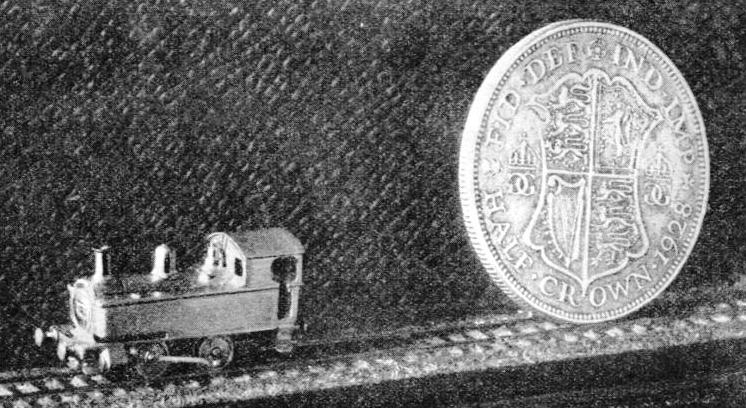
CLAIMED TO BE ONE OF THE SMALLEST SCALE MODELS, this miniature engine runs by electricity on a track only 3/16-in between the rails. The model, the work of Mr. A. R. Walkley, is 1-in long, ½-in high and weighs ½-oz. Its size can be compared with the half crown seen alongside.
Those enthusiasts who decide to use the HO gauge can certainly buy everything they require from the commercial firms that specialize in the necessary equipment. Perfect scale model rails, with chairs and sleepers, may be bought at very reasonable prices, together with signals - both semaphore and colour-light - points, bridges, stations and every type of locomotive, coach, and wagon. It is then necessary only to plan a suitable line, lay the track - usually on a large board - and “open the railway”.
The constructor, however, is served even better, since components and parts for making everything for a model railway can be bought at much less cost than the finished articles. Track can be obtained in the form of proper section (in miniature) brass rails and sleepers of tinplate cut ready to length. A wooden or aluminium jig with recesses to take the sleepers and rails, can be bought quite cheaply, for both straight or curved track. The correct number of sleepers is laid in the jig with the two rails on top, and a light touch with the soldering iron unites rails to sleepers permanently. Chairs in this type of track are dispensed with, and the sleepers are enamelled black after soldering. The completed track with points and cross-overs is pinned to a baseboard of plywood or other suitable material. Finally, electric conductor rails are fixed to the board, alongside the running rails.
Scale Model Signals
One of the great advantages of HO gauge is the compactness of the lay-out - the baseboards for a whole railway system need not tax the accommodation of the average house.
Colour-light signals constitute an essential addition to any electric railway, but with HO gauge the problem is to obtain scale model signals that will work. For Gauge O the miniature electric lamps used for medical work are small enough, but HO demands a smaller size still. Amateurs specializing in this part of the hobby have evolved a neat and clever colour-light signal by using a thin glass rod as the standard, which is painted black. The bottom of the rod is placed over a miniature lamp in the baseboard, and the upper end is bevelled and covered with a scale model hood similar to those used in real practice. The light is reflected up the rod and appears at the bevelled end - red, yellow or green as required.
There are many ways of making coaches for these miniature lines, and they may be of any type - compartment, corridor, or Pullman complete to the last detail, electrically lit and running on a pair of four- or six-wheeled bogies.
One popular method of construction is to use non-inflammable strip celluloid, covered by lithographed art paper, coloured in an exact representation of a coach side. These lithographed art sheets are sold for a few pence, and each sheet comprises the sides, roof and ends of a coach or wagon. They are obtainable in the colours of any of the four British railway groups, and for a large variety of rolling-stock types. The windows on the paper sheets are, of course, cut out with a sharp knife before applying to the celluloid, thus producing the effect of glazing.
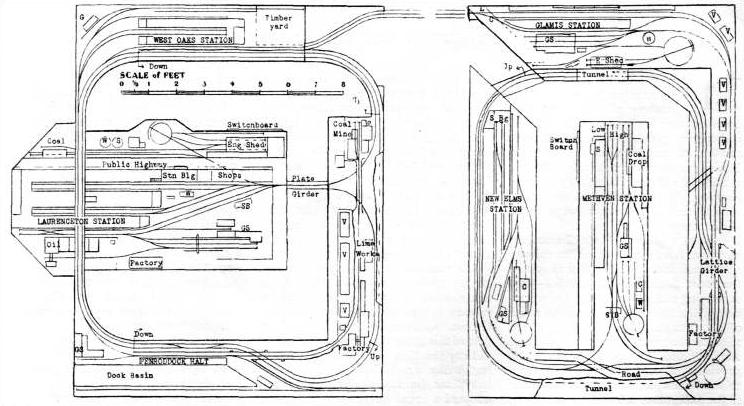
THE LAY-OUT of the Rev. Edward Beal’s railway. This system occupies two rooms; a long viaduct of 9 ft spans the landing. There are six stations and three systems are represented. Most of the rolling-stock employed follows the standard designs of the LMS and LNE railways.
Some people prefer to use the lithographic sheets on a wooden foundation that can also be bought ready shaped, or to build the coach in wood and to paint it in the correct colours. This is a matter for the taste, pocket, or skill of the individual.
Most carriage builders prefer to buy the finished bogies, or at least the axles complete with wheels, as their cost is not excessive and they really require “mass-production” methods of construction - methods that are not usually possessed by the amateur.
A coach intended for use as the power-unit of a scale model electric train, such as those on the LMS or Southern, would be fitted with a motor bogie at one end. These bogies generally contain a permanent magnet and a wound armature, the spindle of which is geared to the driving wheels. The motor picks up electric current, generally between 6 and 8 volts, from a third rail, as in big practice. By using a permanent magnet motor and direct current it is possible to reverse the train while running, from a switch. The speed also can be controlled by means of a resistance.
Similar bogies are used for HO scale models of the steam coaches used by the railway companies for branch-line work. For the models of steam locomotives, such as the GWR “King George V”, the LNER “Flying Scotsman”, the LMS “Princess Royal”, or the SR “Lord Nelson”, special types of electric mechanism are available. These comprise a framework holding a permanent magnet, and are fitted with driving wheels and coupling rods similar to those on the real engines.
Driving Methods
The locomotive builder then constructs the “casing” - the boiler, cab, wheel splashers, and fittings - round the mechanism, thus producing an engine of “steam” outline, driven by electricity. Clockwork is sometimes used for these miniature locomotives - usually with the commercial models imported from the Continent. Steam has been used for these midgets, and a coal-fired model of a boiler for an HO gauge “Pacific” has been exhibited in London. This boiler, made by Mr. G. Kennion, works at 100 lb per sq in and measures ⅜-in long with a firebox ⅞-in cube. Built of copper, this remarkable steam generator has six working fire tubes and a combustion chamber with four water tubes. The boiler fittings - safety valve, regulator, blower, feed clack and firehole door - are all to scale and they all work!
Electricity is, however, the best motive power for HO model railways, as it is efficient and can readily be controlled. In addition, its use ensures cleanliness - an important point where scenic effects are desired.
The scenic side of the HO gauge has been very carefully studied by the commercial firms supplying the necessary material. It is now possible to obtain sheets of paper, printed and coloured to represent bricks, tiles, stonework, and other surfaces to the same scale as the track and rolling-stock. Thus stations, signal cabins, walls, fences, and buildings of all kinds can be constructed in plywood or cardboard and covered with the paper to give a very pleasing effect - and one that is correct to scale.
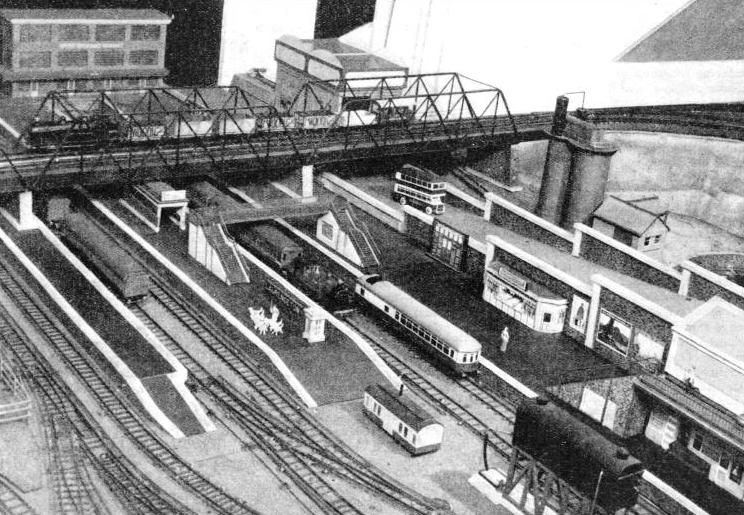
LAURENCETON STATION, the main terminus of the Rev. E. Beal’s system, showing the goods and passenger platforms and a three-span lattice girder bridge. The station is designed after the new Southern Railway station at Hastings, Sussex.
Suitable pictorial backgrounds of various kinds may also be bought, such as landscapes and seascapes, cloud effects, distant towns. When correctly arranged, these add materially to the realistic appearance of a model railway. This is especially true where the line can be permanently laid in a spare room - preferably on trestles or benches arranged round the walls - the latter serving to support the scenic background.
There are literally thousands of these little railways in various parts of the world. The models range from complete systems, with hundreds of feet of track, and locomotives and rolling-stock by the dozen, to single lines with possibly only one engine or coach. The range is infinite and the interest never-ending.
A splendid model railway, owned by the Rev. Edward Beal, of Dundee, is built to a track-gauge of ⅝-in. The layout is erected in two top rooms of a house, between which there is a landing 9 ft wide, a long viaduct spanning this gap to link the two rooms together. There are about 500 ft of main line, the track being made up of brass rail soldered to tinplate sleepers, which are spaced at ½-in centres. The power is electric throughout, and the current is supplied by a single outside conductor rail. Electricity is used where it is inconvenient to operate the points by hand. Other points are operated by scale hand-levers.
Three companies are represented in this system - the West Midland, the Laurenceton, Methven and Southern, and the Laurenceton and New Elms respectively. Laurenceton, on the West Midland, is the main terminus of the system, and the subsidiary lines in the other lay-out take their name from the fact that they link up train services with this terminus from outlying points. By the adoption of these names it will be seen that it is possible to use the standard lettering, coach finish, and so forth, of the LMS and the LNER railways. This is a distinct advantage, when it is remembered that all component parts in this scale are more or less standardized to the British type of railway practice.
An Elaborate System
There are six stations: Laurenceton, Penroddock Docks, and West Oaks on the WMR, Glamis and Methven Junction on the LMS, and New Elms on the LNER. The lay-out includes a number of splendid bridge models - a three-span lattice girder across Laurenceton Station, a single-span lattice near Methven, a plate girder near Laurenceton. Other bridges of a smaller type comprise a skew lattice girder near Penroddock, and a plate girder on the industrial extension beyond that point. There are also three gradients, two of which are rather severe, being on the older section. The other is a very gradual one, at 1 in 90, and locomotives will easily haul a ten-coach train to the summit.
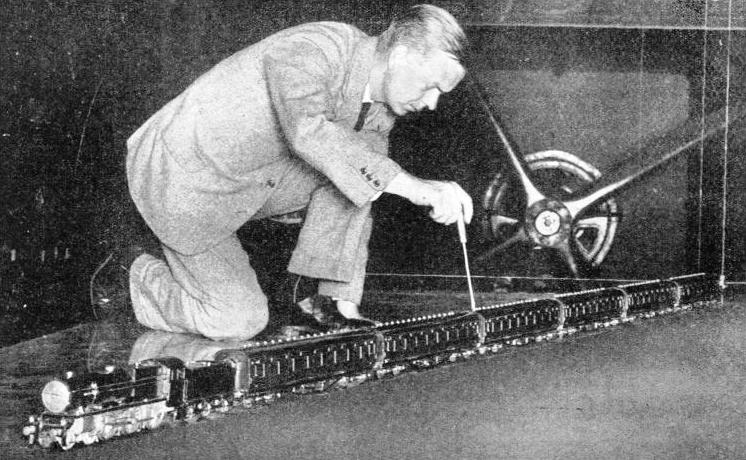
ARTIFICIAL HURRICANES of 120 miles an hour are created in wind tunnels for train tests at the National Physical Laboratory, Teddington, Middlesex. Successful experiments at Teddington have influenced the LMS to build a wind tunnel at Derby. This picture shows a model train being used for a test. The air resistance of the train is studied for streamline designing.
The accompanying plan of the complete lay-out gives all the various details of the respective traffic centres. It will be seen that there are locomotive depots at Laurenceton and at three other smaller stations. The former terminus has a large goods department with a travelling Goliath crane. Methven has a very interesting lay-out, including coal drops located on the high level, and serving lorries below. An outstanding feature is the large dock at Penroddock, which accommodates a large tramp steamer and a paddle-boat, as well as smaller craft. Here there is an all-metal model of a dock crane, all details of shipping and handling appliances being accurately modelled to scale. The vessels in the dock are waterline models, the surface of the basin is composed of sheet glass with a suitably painted surface underneath. At Laurenceton, also, there is a detailed model of a city street, having a motor showroom, a confectioner's shop and the usual station buildings facing it. The station building is designed after the new station at Hastings.
The crossovers below the dock, on the main line, as well as the turnout leading from the main line to Penroddock, are electrically operated, which is a great convenience when working at the switchboard on the other side of the room.
There are two of these main switchboards, one for each lay-out, yet both so arranged by wiring as to work in conjunction. Each panel is provided with two double throwover main switches. One switch controls the main circuit of current for its own lay-out, the other being an “echo” switch for use with a certain 3-ft insulated section of the landing viaduct. This short section is wired so as to be dead when the main current in the two rooms is at opposite polarity. The main switch and the echo switch must be thrown over in the same direction, and in both rooms for the trains to be energized when on this short bridge section. If this is not done, the current is out, and the trains stop until it is put in correctly. Thus all crossing of current in the two rooms is out of the question. The arrangement was necessary because the entire system is supplied from one source of power, this being a rectifier charging 8-volts batteries. It is possible to run a number of engines at once. Many of the tracks, particularly alongside station platforms on turn-tables and in engine-sheds, are “dead-alive” sections controlled by closely-set plug-switches on the panels. This arrangement enables trains at one point to be held stationary while others are run at will. Any separate engine can also thus be run out of a shed without disturbing others. Locomotives can be run on to turn-tables, the current being “off”, and will thereon stop themselves without further attention until the plug-switch is pulled out.
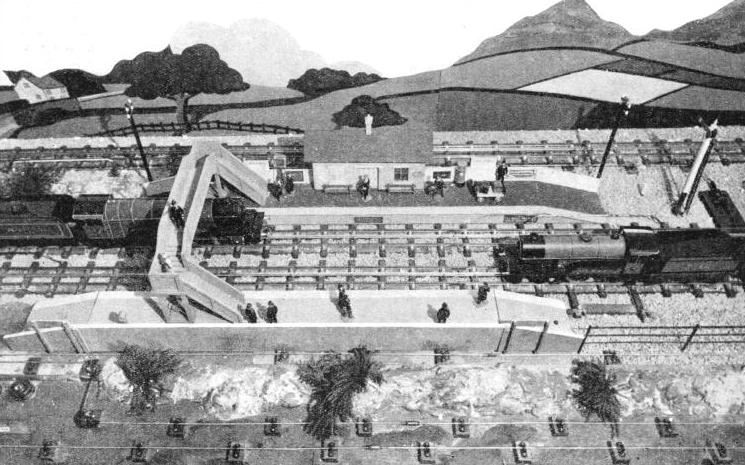
A REALISTIC IMPRESSION is given by this delightful model station. Pictorial backgrounds such as those seen above can be used to improve any private system. This lay-out forms part of a Gauge O system.
Another useful governing device is that of the sectionalizing of each entire lay-out under the control of about twenty plugs, solely for the purpose of discovering instantly a short-circuit. In such a small gauge, when a fairly light rail must be used, and when spacing-margins are not too liberal, the sun and the damp tend to cause slight variations that occasionally lead to temporary short circuits. By using these plugs it becomes possible to isolate every section separately and test it on the ammeter on the panel.
No effort has been spared to make the spectacular effect of the railway attractive. The walls of the rooms are distempered sky-blue, and over this has been arranged a complete series of scenic backgrounds, made mainly from railway posters, ingeniously joined without breaking the continuity of the view. By the use of a little artistic judgment it has been possible to make perfect joints at those points where the edges of the posters come together, and to maintain a good continuity of the design. The whole of the background is finished in this manner.
The rolling-stock of the system comprises a large number of scale passenger coaches of every type - compartment and corridor coaches, triple and quintuple articulated sets for the LNER and WMR, short suburban carriages, dining cars, and brake vans. The bogies fitted are all of designs that are standard to the respective companies; they are of brass throughout. There are fifty scale model goods wagons, open coal trucks, cattle vans with model freights, eight-wheel high capacity vans, meat vans, timber wagons, as well as four-wheel and six-wheel brakes. Every goods wagon is fitted with complete dummy brake and underframe gear, and all external details such as end-door hinge-bars, hand-rails, and so forth. There are about ten locomotives, the heaviest an 0-8-0 goods tank engine that has really wonderful hauling power, the smallest an 0-4-0 shunting locomotive which has outside cylinders and ½-in diameter wheels. In a later chapter we shall be dealing with gauge O and the larger sizes in model railways.
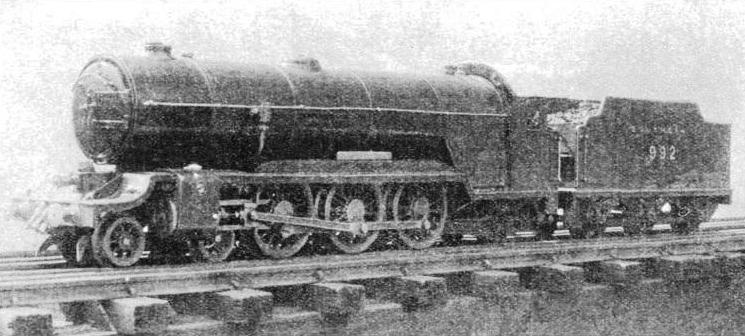
PASSENGER HAULING ON GAUGE O. This locomotive, only 1 ft 9-in long, built for the 1¼-in gauge by Mr. L. Lawrence, burns Welsh steam coal. At 70 lb. boiler pressure the engine has hauled two passengers with a total weight of 224 lb. The engine follows Southern Railway “Pacific” practice, and weighs, with tender, 9 lb.
You can read more on “Miniature Railways”, “Model Railways 2” and “Railway Curiosities” on this website.









